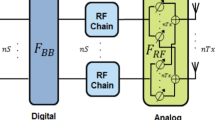Abstract
In this paper, we investigate the downlink multiple-input-multiple-output (MIMO) broadcast channels in which a base transceiver station (BTS) broadcasts multiple data streams to K MIMO mobile stations (MSs) simultaneously. In order to maximize the weighted sum-rate (WSR) of the system subject to the transmitted power constraint, the design problem is to find the pre-coding matrices at BTS and the decoding matrices at MSs. However, such a design problem is typically a nonlinear and nonconvex optimization and, thus, it is quite hard to obtain the analytical solutions. To tackle with the mathematical difficulties, we propose an efficient stochastic optimization algorithm to optimize the transceiver matrices. Specifically, we utilize the linear minimum mean square error Wiener filters at MSs. Then, we introduce the constrained particle swarm optimization algorithm to jointly optimize the precoding and decoding matrices. Numerical experiments are exhibited to validate the effectiveness of the proposed algorithm in terms of convergence, computational complexity and total WSR.




Similar content being viewed by others
References
Telatar, E. (1999). Capacity of multi-antenna gaussian channels. European Transactions on Telecommunications, 10, 585–596.
Foschini, G. J., & Gans, M. J. (1998). On limits of wireless communications in a fading environment when using multiple antennas. Wireless Personal Communications, 6, 311–335.
Goldsmith, A., Jafar, S., Jindal, N., & Vishwanath, S. (2003). Capacity limits of MIMO channels. IEEE Journal on Selected Areas in Communications, 21, 684–702.
Scutari, G., Palomar, D., & Barbarossa, S. (2009). The MIMO iterative waterfilling algorithm. IEEE Transactions on Signal Processing, 57, 1917–1935.
Gesbert, D., Kountouris, M., Heath, R. W, Jr., Chae, C. B., & Salzer, T. (2007). From single user to multiuser communications: Shifting the MIMO paradigm. IEEE Signal Processing Magazine, 24, 36–46.
Weingarten, H., Steinberg, Y., & Shamai, S. (2006). The capacity region of the gaussian multiple-input multiple-output broadcast channel. IEEE Transactions on Information Theory, 52, 3936–3964.
Shen, Z., Andrews, J. G., Heath, R. W, Jr., & Evans, B. L. (2006). Low complexity user selection algorithms for multiuser MIMO systems with block diagonalization. IEEE Transactions on Signal Processing, 54, 3658–3663.
Spencer, Q., Swindlehurst, A., & Haardt, M. (2004). Zero-forcing methods for downlink spatial multiplexing in multiuser MIMO channels. IEEE Transactions on Signal Processing, 52, 461–471.
Zhou, Z., Hardjawana, W., & Vucetic, B. (2008). Iterative multiple beamforming algorithm for mimo broadcast channels. IEEE Communications Letters, 12, 743–745.
Song, B., Roemer, F., & Haardt, M. (2010). Using a new structured joint congruence (STJOCO) transformation of hermitian matrices for precoding in multi-user MIMO systems. In Proceedings of IEEE International Conference on Acoustics Speech and Signal Processing (ICASSP) (pp 3414–3417).
Song, B., Roemer, F., & Haardt, M. (2010). Flexible coordinated beamforming (FlexCoBF) algorithm for the downlink of multi-user MIMO systems. In Proceedings International ITG Workshop on Smart Antennas (WSA) (pp 414–420).
Zheng, G., Ng, T.-S., & Wong, K.-K. (2006). Joint power control and beamforming for sum-rate maximization in multiuser MIMO downlink channels. In Proceedings of IEEE Global Telecommunication Conference (GLOBECOM) (pp. 1–5).
Yu, W., & Cioffi, J. (2004). Sum capacity of Gaussian vector broadcast channels. IEEE Transactions on Information Theory, 50, 1875–1892.
Chen, R., Andrews, J., & Heath, R. (2007). Efficient transmit antenna selection for multiuser MIMO systems with block diagonalization. In proceedings of Globecom, 2007 (pp. 3499–3503).
Kennedy, J., Eberhart, R. (1995). Particle swarm optimization. In proceedings of IEEE International Conference on Neural Networks 1995, Perth, WA (pp. 1942-1948).
Chen, S., Yao, W., Palally, H., & Hanzo, L. (2010). Particle swarm optimisation aided MIMO transceiver designs., Computational intelligence in expensive optimization problems Berlin Heidelberg: Springer.
Poli, R., Kennedy, J., & Blackwell, T. (2007). Particle swarm optimization. Swarm Intelligence, 1, 33–57.
Shu, F., Lihua, L., & Ping, Z. (2008). Optimal multi-user MIMO linear precoding based on particle swarm optimization. In proceedings of ICC2008 (pp. 3355–3359).
Rihan, M., Elsabrouty, M., Muta, O. & Fumkawa, H. Iterative interference alignment in macrocell-femtocell networks: A cognitive radio approach. In proceedings of IEEE ISWCS2014, Barcelona, Spain (pp. 654–658).
Bazzi, S., Dietl, G., & Utschick, W. (2012). Interference alignment via minimization projector distances of interfering subspaces. In proceedings of IEEE SPAWC2012, Cesme, Turkey (pp. 274-287).
Kay, S. M. (1993). Fundamentals of statistical signal processing (Vol. I)., ser. Prentice Hall signal processing series Upper Saddle River (N.J.): Prentice Hall.
Ebbesen, S., Kiwitz, P., & Guzzella, L. (2012). A generic particle swarm optimization matlab function. In proceedings of ACC2012, Montreal, QC (pp. 1519–1524).
Robinson, J., & Rahmat-Samii, Y. (2004). Particle swarm optimization in electromagnetics. IEEE Transactions on Antennas and Propagation, 52, 397–407.
Boyd, S., & Vandenberghe, L. (2004). Convex optimization. New York, NY: Cambridge University Press.
Sung, H., Lee, S.-R., & Lee, I. (2009). Generalized channel inversion methods for multiuser MIMO systems. IEEE Transactions on Communications, 57, 3489–3499.
Papailiopoulos, D. S., & Dimakis, A. G. (2012). Interference alignment as a rank constrained rank minimization. IEEE Transactions on Signal Processing, 60, 4278–4288.
Acknowledgements
This research is funded by Vietnam National Foundation for Science and Technology Development (NAFOSTED) under Grant number 102.04-2013.46.
Author information
Authors and Affiliations
Corresponding author
Rights and permissions
About this article
Cite this article
Vu, T.T., Kha, H.H., Duong, T.Q. et al. Particle Swarm Optimization for Weighted Sum Rate Maximization in MIMO Broadcast Channels. Wireless Pers Commun 96, 3907–3921 (2017). https://doi.org/10.1007/s11277-017-4357-2
Published:
Issue Date:
DOI: https://doi.org/10.1007/s11277-017-4357-2




